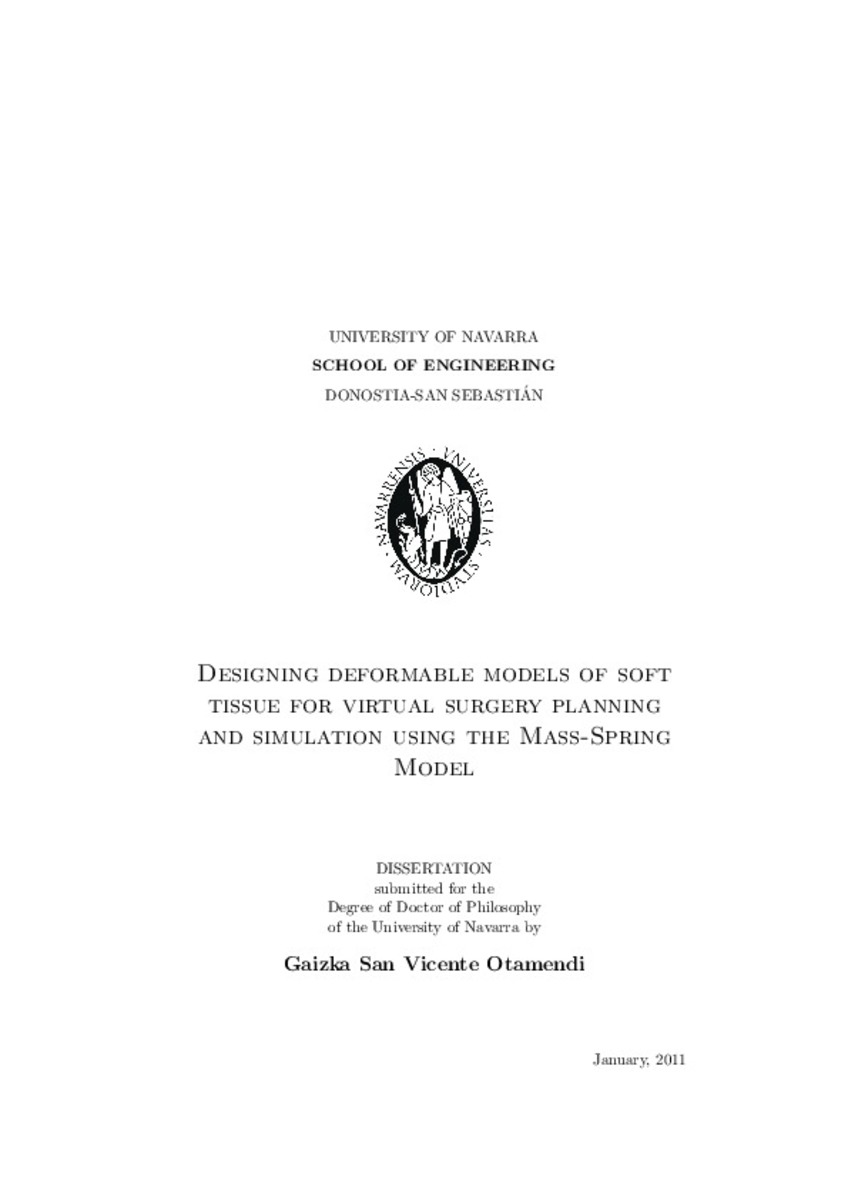Full metadata record
| DC Field | Value | Language |
|---|---|---|
| dc.contributor.advisor | Celigüeta-Lizarza, J.T. (Juan Tomás) | - |
| dc.contributor.advisor | Aguinaga-Hoyos, I. (Iker) | - |
| dc.creator | San-Vicente-Otamendi, G. (Gaizka) | - |
| dc.date.accessioned | 2011-03-08T11:12:45Z | - |
| dc.date.available | 2011-03-08T11:12:45Z | - |
| dc.date.issued | 2011 | - |
| dc.date.submitted | 2011-02-04 | - |
| dc.identifier.citation | SAN VICENTE OTAMENDI, Gaizka ""Designing deformable models of soft tissue for virtual surgery planning and simulation using the Mas-Spring Model"" Celigüeta Lizarza, Juan Tomás y Aguinaga Hoyos, Iker. Tesis doctoral. Universidad de Navarra, 2011 | es_ES |
| dc.identifier.isbn | 84-8081-144-7 | - |
| dc.identifier.uri | https://hdl.handle.net/10171/16875 | - |
| dc.description.abstract | Surgery simulators, biomechanical studies and some virtual reality applications require the handling of the mechanical behaviour of different biological tissue types. Each tissue type reacts in different ways to the action of the external loads applied onto the object. In particular, designing suitable mechanical models to represent the behaviour of soft tissue is a challenging task. Many models for deformable bodies have been proposed to approximate the behaviour of living deformable tissues. However, it is difficult to fulfil simultaneously two basic requirements: fast computation of the deformations and accuracy in the results. This challenge is even greater when the working environment requires real-time results, like in the case of interactive surgical simulators. In this thesis two new methods to design fast and accurate Mass- Spring Model (MSM) are proposed. The methods are specifically focused on the simulation of deformable tissues. The first method allows modelling the linear elastic behaviour under small deformations. In particular, it is based on the comparative analysis of the linearized system of equations of the MSM and a linear elastic Finite Element Method (FEM). This is performed by studying the eigenvalues and eigenvectors of the corresponding models. The second method allows designing soft-tissue models valid in the range of large deformations. This method is based on the fact that MSMs intrinsically behave nonlinearly under loads that lead to large deformations. In particular, a uniaxial tensile test is made to obtain the parameters of the MSM from material models or experimental data. Finally, the models proposed in this thesis have been implemented in medical simulators prototypes. The results suggest that MSMs can be an interesting alternative to other models such as FEM when the requirement on the computation efficiency is more important than model accuracy. | es_ES |
| dc.language.iso | eng | es_ES |
| dc.publisher | Servicio de Publicaciones. Universidad de Navarra. | es_ES |
| dc.subject | Mass-Spring Model | es_ES |
| dc.subject | Soft tissue | es_ES |
| dc.subject | Virtual Reality | es_ES |
| dc.subject | Surgery simulation | es_ES |
| dc.subject | Biomechanics | es_ES |
| dc.title | Designing deformable models of soft tissue for virtual surgery planning and simulation using the Mas-Spring Model | es_ES |
| dc.type | info:eu-repo/semantics/doctoralThesis | es_ES |
Files in This Item:
Statistics and impact
Items in Dadun are protected by copyright, with all rights reserved, unless otherwise indicated.






